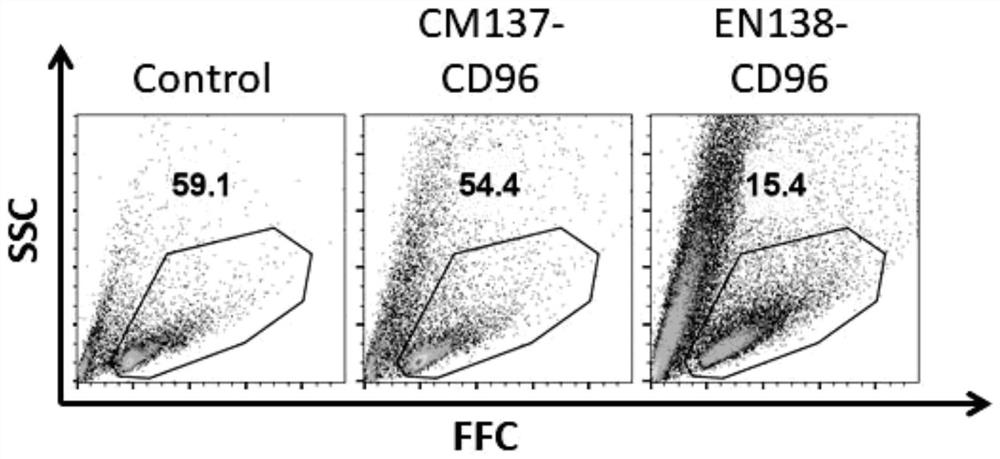A method for efficient knockout of cd96 gene in nk cells
A high-efficiency technology for NK cells, applied in the field of gene editing, to achieve high knockout efficiency, improved recognition and killing activity, obvious application prospects and clinical application value
- Summary
- Abstract
- Description
- Claims
- Application Information
AI Technical Summary
Problems solved by technology
Method used
Image
Examples
Embodiment 1
[0034] A method for efficiently knocking out CD96 gene in NK cells, comprising the following specific steps:
[0035] 1. Expansion and culture of NK cells
[0036] 1) Take out the cryopreserved human peripheral blood mononuclear cells (PBMC) from liquid nitrogen and thaw rapidly in a 37°C water bath;
[0037] 2) Add 4 mL of RPMI-1640 complete culture medium containing 10% FBS and 1% penicillin / streptomycin double antibody to a new 15 mL centrifuge tube, and transfer 1 mL of PBMC suspension to a 15 mL centrifuge tube;
[0038] 3) Centrifuge at 250 × g for 5 min at room temperature;
[0039] 4) Discard the supernatant and resuspend the cells with 1 mL of RPMI-1640 medium;
[0040] 5) Add 19mL RPMI-1640 culture solution to a new 75mL cell culture flask, and transfer the above cell suspension to the culture flask;
[0041] 6) Add human recombinant IL-2 protein to the culture flask, and the final concentration is 200U / mL;
[0042] 7) Put the culture flask at 37°C, 5% CO 2 In t...
Embodiment 2
[0073] Gene knockout efficiency was detected by flow cytometry:
[0074] 1) Collect wild-type or CD96 knockout NK cells and wash twice with 1×PBS containing 1% fetal bovine serum (FBS);
[0075] 2) Resuspend the cells in PBS containing 1% FBS and count, and adjust the cell concentration to 3×10 6 pcs / mL;
[0076] 3) Add 50 μL of the above cell suspension into a new 1.5 mL centrifuge tube, add 1 μL of PE-anti TIGTI antibody, and incubate at 4°C for 30 min in the dark;
[0077] 4) Wash twice with 1% FBS 1×PBS;
[0078] 5) Resuspend the cells with 300 μL of 1% FBS 1×PBS and perform flow cytometry detection.
[0079] Test results such as Figure 2A and 2B shown, by Figure 2A and 2B It can be seen from the results shown: sgRNA-5, 9 and 10 have higher knockout efficiency, as shown in Table 1:
[0080] Table 1 Detection of CD96 knockout efficiency by flow cytometry
[0081]
[0082]
[0083] It can be seen from the results in Table 1: under the same conditions, the sg...
Embodiment 3
[0085] The phosphorylation-modified gRNA targeting CD96 was purchased from GenScript Biotechnology Co., Ltd., and the specific phosphorylation sites were: 3 thio groups and methoxy groups at the 3' and 5' ends respectively.
[0086] CD96-10: GCTGTCTATCATCCCCAATA
[0087] Depend on image 3 The results shown are: the percentage of CD56+ / CD96+ NK cells in wild-type NK cells is 96.5%, and the CD96-10 gRNA modified by phosphorylation can reduce the percentage of CD56+ / CD96+ NK cells to 67.4% without phosphorylation modification. The CD96-10 gRNA can only be reduced to 90.4%, indicating that the phosphorylation-modified sgRNA has better stability and stronger activity. The specific results are shown in Table 2:
[0088] Table 2 Detection of CD96 knockout efficiency by flow cytometry
[0089] name Percentage of CD56+ / CD96+ NK cells (%) Knockout rate (%) WT 96.5 0 Phosphorylated CD96-10 67.4 29.1 Unmodified CD96-10 90.4 6.1
PUM
 Login to View More
Login to View More Abstract
Description
Claims
Application Information
 Login to View More
Login to View More - R&D
- Intellectual Property
- Life Sciences
- Materials
- Tech Scout
- Unparalleled Data Quality
- Higher Quality Content
- 60% Fewer Hallucinations
Browse by: Latest US Patents, China's latest patents, Technical Efficacy Thesaurus, Application Domain, Technology Topic, Popular Technical Reports.
© 2025 PatSnap. All rights reserved.Legal|Privacy policy|Modern Slavery Act Transparency Statement|Sitemap|About US| Contact US: help@patsnap.com



